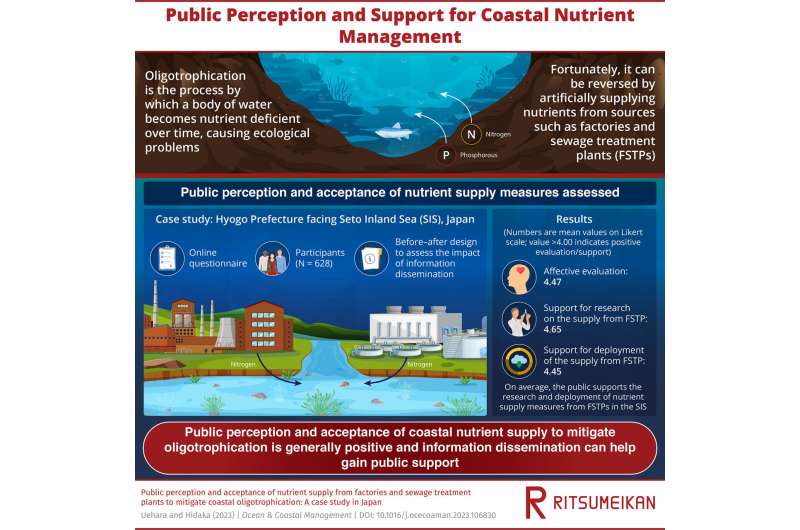This article has been reviewed according to Science X's editorial process and policies. Editors have highlighted the following attributes while ensuring the content's credibility:
fact-checked
proofread
Surveying public support for plans to combat nutrient depletion in a large inland sea

Human activities can drastically alter the nutrient balance in ecosystems, causing long-lasting problems for wildlife. Coastal oligotrophication, the process by which a coastal ecosystem becomes progressively less enriched with nutrients over time, is a problem that is becoming increasingly important.
For example, the Seto Inland Sea (SIS), a large water body in Japan. is currently facing oligotrophication due to a lack of nitrogen and phosphorous. This has caused a decline in fish catch rates and the bleaching of cultured nori seaweed, threatening important local food sources. Managing oligotrophication is challenging, and gaining public support is essential for the success of any management plan.
In 2022, Hyogo Prefecture implemented one of the most comprehensive management plans ever to combat oligotrophication at SIS. The plan includes five measures: nutrient supply from factories and sewage treatment plants (FSTP), fertilization, seabed plowing, drainage, and conservation, rehabilitation, and establishment of seaweed beds and tidal flats.
The nutrient supply from FSTP is the most controversial measure, as it is associated with experiences of eutrophication during high economic growth, prompting the government to ensure public support and accountability for the nutrient supply plan.
In a recent study published in the journal Ocean & Coastal Management, Professor Takuro Uehara from Ritsumeikan University, Japan and his colleague investigated the public perception and acceptance of the nutrient supply measures.
"We conducted five online surveys to assess the public perception and acceptance of the five nutrient supply measures to mitigate coastal oligotrophication in SIS. For each of these surveys, we received responses from over 600 participants," explains Prof. Uehara. However, the paper primarily focuses on nutrient supply from FSTPs. It is worth noting that, a before–after design was used to assess the impact of the dissemination of information on the residents' perceptions of these five measures.
The study found that respondents were unfamiliar with plans involving nutrient supply from FSTPs. Surprisingly, this measure was positively perceived on average, contrary to initial expectations. Furthermore, presenting information to participants significantly improved the affective evaluation of the measure, proving that many negative opinions were based on a lack of knowledge or misunderstandings. However, it is noteworthy that the nutrient supply from FSTPs ranked lowest in terms of perceived value across various aspects.
Despite some hesitancy regarding the deployment of this method, the public expressed support for further research into it. Additionally, the level of public support for research and deployment of the nutrient supply from FSTP correlated with their knowledge of the problems facing the SIS and their involvement with the area. These factors also impacted how the public perceived and accepted the nutrient supply measures.
"There was a concern that the public might associate nutrient supply from FSTPs with a negative preconception of 'polluting the coastal sea'. However, our study revealed that, contrary to the concern, it was on average, positively perceived and accepted. This support can in turn, assist the implementation of various measures and the public can benefit from more seafood," concludes Prof. Uehara.
This study is the first to reveal the public perception and acceptance of increasing coastal nutrient supply. The main takeaway is that raising awareness of the problem is critical for ensuring public support. Additionally, it is essential to prioritize communication of the proposed measures to the public. Consequently, further research is warranted to devise effective strategies for securing public backing in the efforts to combat oligotrophication through nutrient management.
More information: Takuro Uehara et al, Public perception and acceptance of nutrient supply from factories and sewage treatment plants to mitigate coastal oligotrophication: A case study in Japan, Ocean & Coastal Management (2023). DOI: 10.1016/j.ocecoaman.2023.106830
Provided by Ritsumeikan University



















